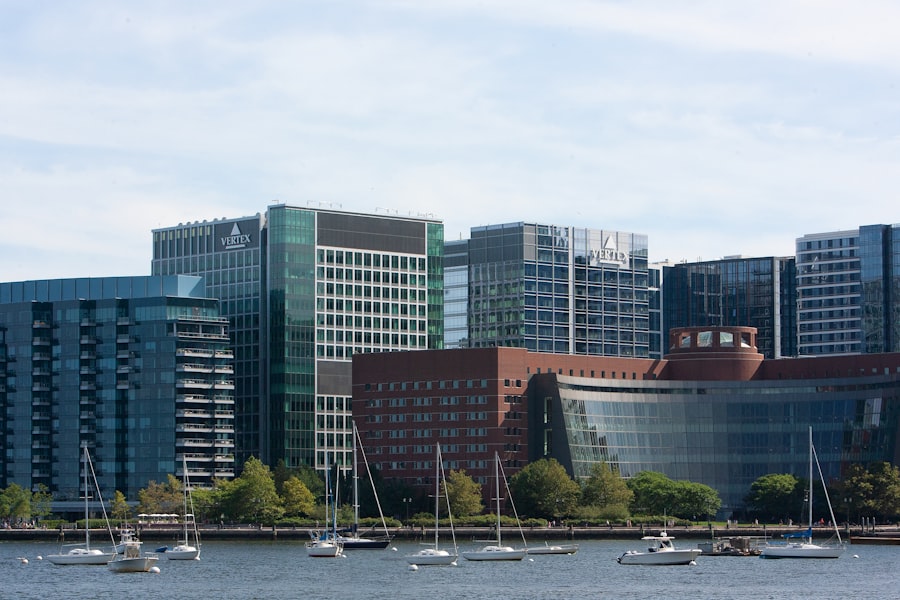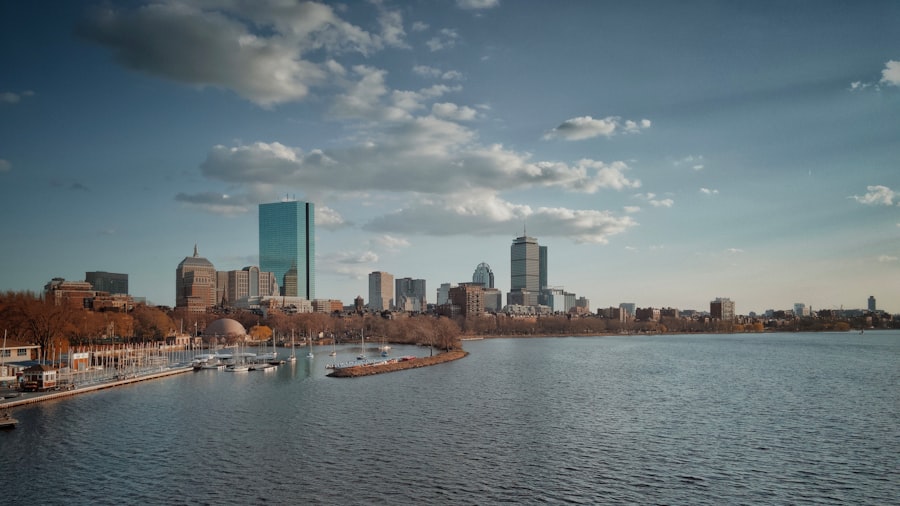Boston’s urban landscape has undergone a remarkable transformation over the centuries, evolving from a colonial settlement into a bustling metropolis. Founded in 1630, Boston was initially characterized by its narrow, winding streets and a compact layout that reflected its colonial roots. The early architecture was predominantly utilitarian, with wooden structures that served the needs of a growing population.
As the city expanded, the introduction of brick and stone buildings marked a shift towards more permanent and aesthetically pleasing structures. The Great Fire of 1872, which devastated a significant portion of the downtown area, catalyzed a wave of reconstruction that introduced modern architectural styles and urban planning principles. The late 19th and early 20th centuries saw Boston embrace industrialization, leading to the development of new neighborhoods and the expansion of existing ones.
The construction of the subway system in 1897 was a pivotal moment in the city’s evolution, facilitating greater mobility and encouraging suburban growth. The post-World War II era brought about further changes, as urban renewal projects sought to modernize the city while often displacing long-standing communities. Today, Boston’s skyline is a blend of historic landmarks, such as the Old State House and Faneuil Hall, alongside contemporary skyscrapers like the John Hancock Tower and the Prudential Center.
This juxtaposition of old and new reflects the city’s rich history while accommodating the demands of a modern urban environment.
Key Takeaways
- Boston’s urban landscape has transformed significantly, blending historic preservation with modern development.
- Major infrastructure and transportation projects have improved connectivity and accessibility across the city.
- Economic growth is driven by expanding commercial sectors, including technology and finance.
- Housing trends show rising demand, with efforts to balance affordability and new real estate developments.
- Cultural, educational, and environmental initiatives contribute to Boston’s vibrant community and sustainable future.
Infrastructure and Transportation Developments
Boston’s infrastructure has been shaped by its unique geography and historical context, leading to a complex transportation network that includes roads, railways, and waterways. The city’s layout, characterized by its irregular street patterns and limited space due to its location on the Shawmut Peninsula, has necessitated innovative solutions to transportation challenges. The Massachusetts Bay Transportation Authority (MBTA), established in 1964, has played a crucial role in providing public transit options that connect various neighborhoods and suburbs to the city center.
The subway system, known as the “T,” is one of the oldest in the United States and continues to be a vital component of Boston’s transportation infrastructure. In recent years, Boston has also focused on enhancing its infrastructure to accommodate the growing population and increasing traffic congestion. Projects such as the Big Dig, which involved rerouting the Central Artery underground, have transformed the city’s roadways and improved air quality by reducing surface-level traffic.
Additionally, investments in cycling infrastructure, including dedicated bike lanes and bike-sharing programs like Bluebikes, reflect a commitment to promoting sustainable transportation options. The ongoing development of the South Station expansion aims to improve commuter rail services and enhance connectivity with regional transit systems, further solidifying Boston’s role as a transportation hub in New England.
Economic and Commercial Expansion

Boston’s economy has evolved significantly over the years, transitioning from a manufacturing-based economy to one driven by technology, education, and healthcare. The city’s strategic location along the Atlantic coast has historically made it a center for trade and commerce. In recent decades, however, Boston has emerged as a global leader in innovation and entrepreneurship.
The presence of prestigious institutions such as Harvard University and the Massachusetts Institute of Technology (MIT) has fostered a vibrant ecosystem for startups and established companies alike. The financial sector has also seen substantial growth, with Boston becoming home to numerous investment firms and banks. The Seaport District, once an industrial area, has been revitalized into a bustling commercial hub featuring office spaces for tech companies, restaurants, and retail establishments.
This transformation has attracted significant investment and created thousands of jobs, contributing to the city’s overall economic expansion. Furthermore, Boston’s commitment to fostering diversity in its economy is evident through initiatives aimed at supporting minority-owned businesses and promoting inclusive growth.
Housing and Real Estate Trends
| Metric | 2022 | 2023 | Change (%) | Notes |
|---|---|---|---|---|
| Median Home Price | 350,000 | 365,000 | 4.3 | Steady increase due to demand |
| Average Mortgage Rate (%) | 3.5 | 5.1 | 45.7 | Rising rates impacting affordability |
| Housing Inventory (Months) | 2.5 | 3.0 | 20 | More homes available on market |
| New Construction Starts (Thousands) | 1,200 | 1,150 | -4.2 | Supply chain delays affecting projects |
| Rental Vacancy Rate (%) | 5.0 | 4.7 | -6 | Strong rental demand |
| Homeownership Rate (%) | 65.8 | 65.2 | -0.9 | Minor decline due to affordability |
The housing market in Boston has experienced significant fluctuations over the years, influenced by economic conditions, demographic shifts, and urban development policies. As demand for housing has surged due to population growth and an influx of young professionals, real estate prices have skyrocketed. The city’s limited land availability has exacerbated this issue, leading to increased competition for housing in desirable neighborhoods.
Consequently, many residents have found themselves priced out of traditional areas like Beacon Hill or Back Bay, prompting a search for more affordable options in surrounding suburbs. In response to these challenges, Boston has implemented various strategies to increase housing supply and promote affordability. Initiatives such as inclusionary zoning require developers to allocate a portion of new residential units for low- to moderate-income households.
Additionally, the city has invested in public housing projects and partnerships with nonprofit organizations to create affordable housing options. The trend towards mixed-use developments is also gaining traction, as new projects incorporate residential units alongside commercial spaces to foster vibrant communities. However, despite these efforts, the ongoing demand for housing continues to pose challenges for policymakers seeking to balance growth with affordability.
Cultural and Educational Advancements
Boston’s cultural landscape is as rich as its history, with a diverse array of institutions that contribute to its vibrant arts scene. The city is home to world-renowned museums such as the Museum of Fine Arts and the Isabella Stewart Gardner Museum, which attract millions of visitors each year. Additionally, Boston’s theater district showcases a variety of performances ranging from Broadway shows to local productions, reflecting the city’s commitment to supporting the arts.
The annual Boston Arts Festival celebrates local talent and fosters community engagement through art. Education is another cornerstone of Boston’s identity, with its concentration of prestigious universities and colleges earning it the title of “Athens of America.” Institutions like Harvard University, MIT, Boston University, and Northeastern University not only provide high-quality education but also contribute significantly to research and innovation. The collaboration between academia and industry has led to groundbreaking advancements in fields such as biotechnology and engineering.
Furthermore, educational outreach programs aim to bridge gaps in access to quality education for underserved communities, ensuring that all residents can benefit from Boston’s educational resources.
Environmental Sustainability Initiatives

As urbanization continues to impact cities worldwide, Boston has taken proactive steps toward environmental sustainability. Recognizing the importance of addressing climate change and promoting green practices, the city has implemented various initiatives aimed at reducing its carbon footprint. One notable effort is the “Boston Climate Action Plan,” which outlines strategies for reducing greenhouse gas emissions by 25% by 2020 compared to 2005 levels.
This plan emphasizes energy efficiency in buildings, sustainable transportation options, and increased green space. The city has also invested in renewable energy sources such as solar power and wind energy. Programs encouraging residents to adopt solar energy solutions have gained traction, with incentives provided for installing solar panels on homes and businesses.
Additionally, Boston’s commitment to expanding green spaces is evident through projects like the Emerald Necklace park system and community gardens that promote biodiversity while enhancing residents’ quality of life. These initiatives not only contribute to environmental sustainability but also foster community engagement by encouraging residents to participate in local conservation efforts.
Community and Social Impact
The social fabric of Boston is woven from its diverse communities that contribute to the city’s unique character. However, issues such as income inequality and access to resources remain pressing challenges that require attention. Community organizations play a vital role in addressing these disparities by providing essential services such as food assistance, job training programs, and educational support for low-income families.
Initiatives aimed at fostering social cohesion have emerged in response to these challenges, promoting dialogue among different cultural groups within the city. Moreover, Boston’s commitment to social justice is reflected in its advocacy for equitable policies that address systemic inequalities. Grassroots movements have mobilized around issues such as affordable housing, police reform, and access to healthcare services.
The city’s leadership has responded by engaging with community stakeholders to develop policies that prioritize inclusivity and equity. Programs aimed at empowering marginalized communities through education and economic opportunities are essential components of this effort, ensuring that all residents can thrive in Boston’s evolving urban landscape.
Future Prospects and Challenges
Looking ahead, Boston faces both exciting prospects and significant challenges as it navigates an ever-changing urban environment. The city’s strong economy continues to attract talent from across the globe; however, this influx places additional pressure on housing markets and infrastructure systems already strained by existing demands. Balancing growth with sustainability will be crucial as policymakers seek innovative solutions that address these challenges while maintaining Boston’s unique character.
Furthermore, climate change poses an existential threat that requires immediate action from city leaders. Rising sea levels threaten coastal neighborhoods while extreme weather events become increasingly common. Developing resilient infrastructure capable of withstanding these challenges will be paramount for ensuring public safety and preserving quality of life for residents.
As Boston continues its journey toward becoming a more inclusive and sustainable city, collaboration among government agencies, community organizations, businesses, and residents will be essential in shaping a future that reflects shared values while addressing pressing urban issues head-on.




